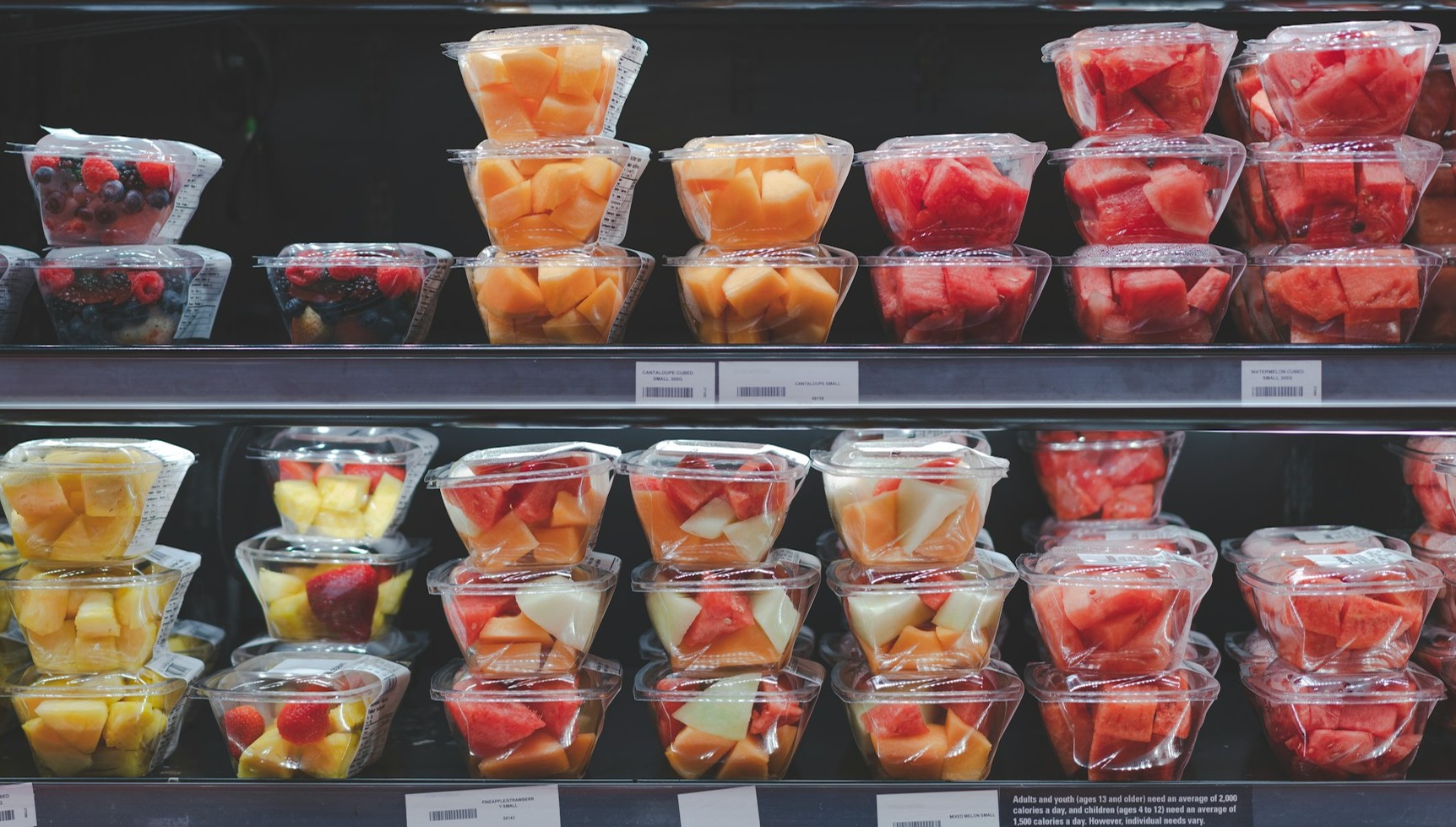From Bin to Win: Reducing Food Waste
ကျွန်တော်တို့ ဒီနေ့ Sharing လုပ်ပေးသွားမယ့် အကြောင်းအရာလေးကတော့ ကျွန်တော်တို့လူသားတွေ နေ့စဉ်သတိမမူမိပဲ ကျူးလွန်မိနေတဲ့ အစာစွန့်ပစ်ခြင်းဆိုတဲ့ Food Waste အကြောင်းလေးနဲ့ ထိုစွန့်ပစ်လိုက်တဲ့ Food Waste တွေက ကျွန်တော်တို့ပတ်ဝန်းကျင်အပေါ် ဘယ်လိုဆိုကျိုးတွေ သက်ရောက်မှုတွေ ရှိနိုင်သလဲဆိုတဲ့အကြောင်းလေးပဲဖြစ်ပါတယ်။
ကျွန်တော်တို့တွေက အိမ်မှာပဲဖြစ်ဖြစ်၊ စားသောက်ဆိုင်မှာပဲဖြစ်ဖြစ် စားလို့မကုန်ရင် လွှင့်ပစ်လိုက်ကြတာတွေကြီးပါပဲ။ ဟုတ်တယ်မလား? ဒီလိုစွန့်ပစ်ခြင်းကနေရာတော်တော်များများမှာ ဖြစ်နေပါတယ်။ အဲ့ဒီကနေ Food Waste ဆိုတာပေါ် လာပါတယ်။
The next topic we are going to share with you guys today is about the food waste that we humans generate daily without realizing its impact and how this discarded food waste negatively affects our environment
Whether it's at home or at a restaurant, we discard unconsumed food, right? This disposal occurs in many locations, giving rise to food waste.
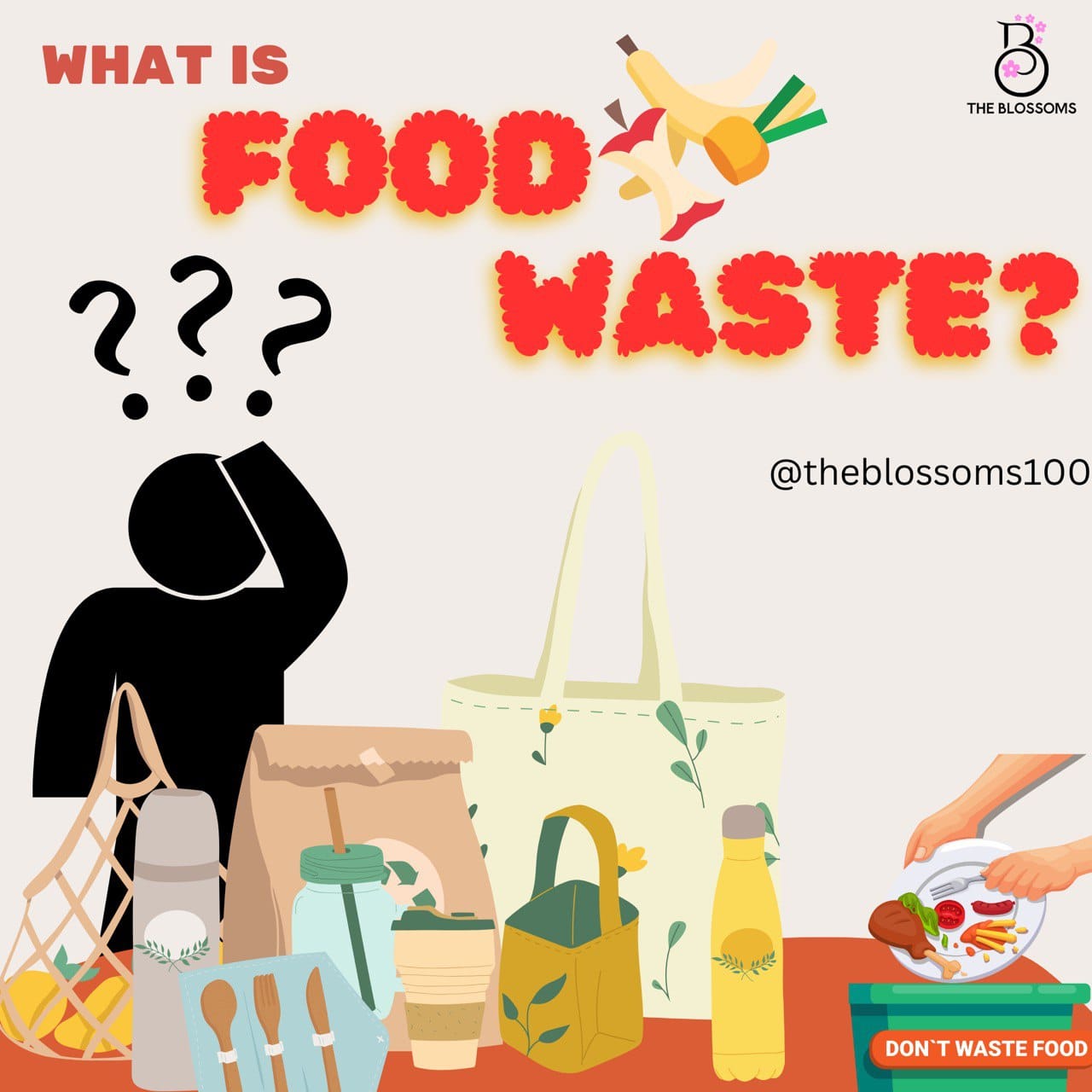
Food Waste ဆိုတာဘာလဲ?
လွယ်လွယ်ပြောရရင်တော့ Food Waste ဆိုတာကျွန်တော်တို့လူသားတွေအတွက်စားသုံးရန် ထုတ်လုပ်ထားတဲ့ဟာတွေကို မစားသုံးပဲ စွန့်ပစ်လိုက်တာမျိုးကိုပြောတာပါ။ Food Waste ကြောင့် ကုန်ကြမ်းတွေ၊ အစားအသောက်တွေမကုန်သင့်ပဲကုန်ရပါတယ်။ ချမ်းသာတဲ့ နိုင်ငံတွေမှာ အဖြစ်ပိုများပါတယ်။
တစ်ကမ္ဘာလုံးရဲ့ အစာစွန့်ပစ်မှုပမာဏက လူသုံးဘီလီယံကို ကျွေးမွေးရန် လုံလောက်ပြီး၊ ဥရောပရှိ အစားအစာစွန့်ပစ်မှုသည် လူသန်း ၂၀၀၊ လက်တင်အမေရိကတွင် သန်း ၃၀၀ နှင့် အာဖရိကတွင် လူသန်း ၃၀၀ တို့ကို ကျွေးမွေးနိုင်ပါတယ်။ ကျွန်တော်တို့တွေက အစာနည်းနည်းပဲ စွန့်ပစ်တာဘာမှဖြစ်မသွားပါဘူးလို့ ထင်ရင်တော့ မှားနေပါပြီ။ လူတစ်ယောက်စီကနည်းနည်းဆိုပြီး လူတွေအများကြီးစွန့်ပစ်တဲ့အခါ Food waste ဆိုတဲ့ပြဿနာက ပိုကြီးလာပါတယ်။
ကမ္ဘာကြီးမှာလူတွေတိုးသထက်တိုးလာပြီး မကြာခင် ၉ ဘီလီယံတောင်ရောက်တော့မှာပါ။ အဲ့တော့ အစားအစာတွေလည်း ပိုပြီး ထုတ်လာရတော့မှာပါ။ ထိုများပြားလာတဲ့ လူဦးရေတွေအတွက် အစာတွေထုတ်လုပ်နိုင်ရင်ဘာမှမဖြစ်ပေမဲ့ လူဦးရေနဲ့ အမျှ ကမ္ဘာကြီးမှာရှိတဲ့ Resources တွေကမလောက်တော့ရင် ပြဿနာအကြီးကြီးဖြစ်နိုင်ပါတယ်။ ကျွန်တော်တို့တွေက ချွေတာနိုင်သလောက်ချွေတာပြီး အစားအစာကို မစွန့်ပစ်ရင် အစားအစာတွေကပိုပြီး ရေရှည်အတွက်လုံလောက်ပြီး ဆာလောင်မွတ်သိပ်ခြင်းနဲ့ကြုံရမဲ့အဖြစ်ဆိုးကို မဖြစ်အောင်တားစီးနိုင်မှာပဲ ဖြစ်ပါတယ်။
What is food waste?
In simple terms, food waste refers to food intended for human consumption that is thrown away instead. Food waste depletes raw materials and food supplies, and the issue is especially prevalent in developed and affluent countries.
The global volume of wasted food is sufficient to feed three billion people, with Europe's food waste capable of feeding 200 million people, Latin America's 300 million people, and Africa's 300 million people. It's a mistake to believe that discarding small amounts of food will have insignificant effects. Food waste compounds when numerous individuals each discard small amounts.
As the world's population grows and approaches 9 billion, more food will need to be produced to meet demand. Failing to keep up with food demand will lead to unprecedented food shortages and a humanitarian crisis. By reducing food waste and conserving as much as we can, we can ensure there’s enough food for everyone and prevent the tragedy of starvation.
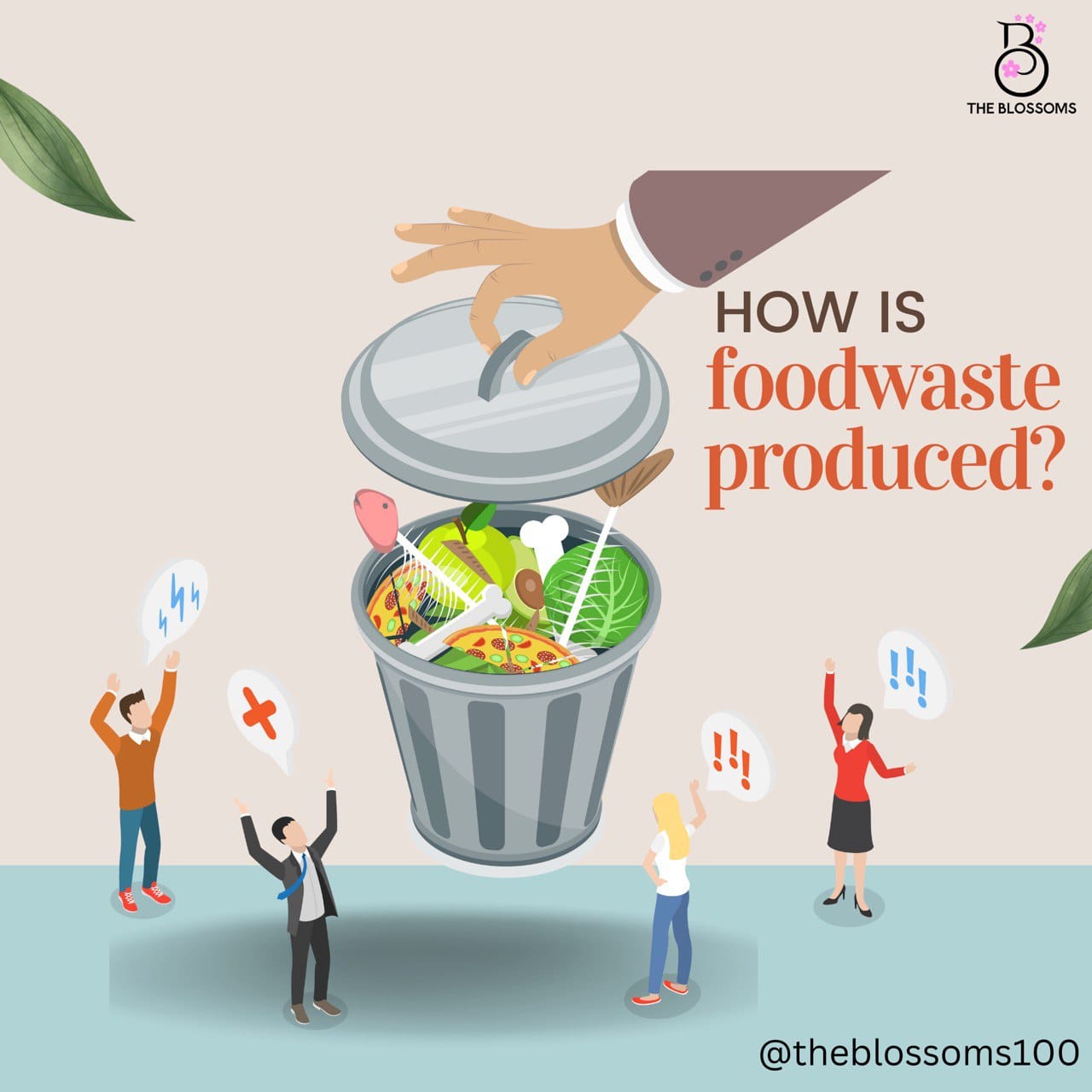
Food Waste ဆိုတာဘာလဲသိပြီးသွားပြီဆိုတော့ Food waste ဖြစ်ရတဲ့အကြောင်းရင်းလေးတွေကိုလည်း ပြောပြပေးချင်ပါတယ်။ တစ်နှစ်တာရဲ့ Food waste ဟာ World's food ရဲ့ သုံးပုံတစ်ပုံ(1.3 Billion Tons အထိရှိနေပါတယ်)။ ဒီလောက်ထိများပြားတဲ့ Food waste ပမာဏကိုဖြစ်စေတဲ့အကြောင်းရင်းတွေကတော့ ကျွန်တော်တို့ကိုယ်တိုင်သတိမထားမိဘဲ နေ့စဥ်နေ့တိုင်းပြုလုပ်လေ့ရှိနေတဲ့ အလေ့အကျင့်လေးတွေဖြစ်ပါတယ်။
1. စိုက်ခင်းတွေမှာဆိုရင် အပင်ဖျက်ပိုးတွေ၊ အပင်မှာကျတဲ့ ရောဂါပိုးမွှားတွေကြောင့် သီးနှံတွေပျက်စီးတာတွေဖြစ်ပြီး ပျက်စီးသွားတဲ့သီးနှံတွေ၊အသီးအရွက်တွေကို စွန့်ပစ်ရတာကြောင့်ဖြစ်ပါတယ်။
2. စိုက်ခင်းတွေကရလာတဲ့ အသီးအနှံတွေ၊ထွက်ကုန်တွေကို မလိုအပ်ဘဲအလွန်အကျွံရိတ်သိမ်းတာတွေ၊ မမှန်ကန်တဲ့ရိတ်သိမ်းမှုတွေကြောင့်လည်း သီးနှံထွက်ကုန်တွေဟာ ပျက်စီးသွားရပါတယ်။
3. ရိတ်သိမ်းပြီးလို့ရလာတဲ့ အသီးအနှံတွေ၊ဟင်းသီးဟင်းရွက်တွေကို တစ်နေရာကနေတစ်နေရာကိုပြောင်းရွေ့တာ၊ သယ်ယူတာ၊ ဖြန့်ဖြူးတာတွေလုပ်ဆောင်တဲ့အခါ ထိခိုက်တာတွေ၊ပွန်းပဲ့သွားတာတွေကတစ်ဆင့် အသီးအရွက်တွေပုပ်သိုးပျက်စီးတာတွေဖြစ်လာပြီး လွှင့်ပစ်လိုက်ရတဲ့အတွက်ဖြစ်ပါတယ်။
4. ဒါတွေအပြင် တစ်ဆင့်ဖြန့်ဖြူးရောင်းချတဲ့သူတွေက စိုက်ခင်းကရတဲ့အသီးအနှံတွေကို သတ်မှတ်ထားတဲ့ အရည်အသွေးနဲ့မကိုက်ညီဘူး၊အမြင်မလှဘူး၊ထိခိုက်တာတွေပါလာတယ်ဆိုပြီး သီးနှံတွေကို လက်မခံဘဲလွှင့်ပစ်ကြပြီးတော့ ကျွန်တော်တို့စားသုံးသူတွေအနေနဲ့လည်း ဒီလိုအသီးတွေ၊ဟင်းသီးဟင်းရွက်တွေကို မစားဘဲစွန့်ပစ်လိုက်ကြတဲ့အတွက်ဖြစ်ပါတယ်။
5. အသီးအရွက်တွေ၊ သစ်သီးတွေကို Shops, Supermarket စတဲ့နေရာတွေမှာ Packaging လုပ်ပြီးသိမ်းဆည်းရောင်းချကြပါတယ်။ ဒီလို Packaging လုပ်ထားတဲ့စားသောက်ကုန်တွေဟာထားသိုမှု၊ သိမ်းဆည်းမှုပုံစံမမှန်ကန်တဲ့အခါ စားလို့မရတဲ့ အနေအထားဖြစ်သွားပြီးတော့ လွှင့်ပစ်ရတဲ့အတွက်ဖြစ်ပါတယ်။
6. စားသောက်ကုန်လုပ်ငန်းတွေဆိုရင်လည်း ကိုယ့်ရဲ့ထုတ်ကုန်များများရောင်းချနိုင်ဖို့အတွက် ထုတ်ကုန်တွေအများကြီးထုတ်လုပ်ကြပါတယ်။စားသောက်ကုန်ဆိုတာက Exp Date ရှိတဲ့အတွက်ကြောင့် သတ်မှတ်ရက်နီးတဲ့ထုတ်ကုန်တွေ၊သက်တမ်းကုန်သွားတဲ့ထုတ်ကုန်တွေ ရောင်းမကုန်တဲ့အခါ မလိုအပ်ဘဲ Food Waste ဖြစ်သွားရပါတယ်။
7. အပိုအလျှံ၀ယ်ယူခြင်းကလည်း Food Waste ဖြစ်စေတဲ့အကြောင်းရင်းထဲမှာပါ၀င်ပါတယ်။ စားသောက်ကုန်၊ အသီးအနှံ၊ စားစရာတွေကို ကိုယ်စားနိုင်တဲ့ပမာဏလောက်ဘဲ၀ယ်တာက အကောင်းဆုံးပါပဲ ။ မလောက်ငှလို့ထပ်၀ယ်လိုက်ရတာက အဆင်ပြေပေမဲ့ စားမကုန်တဲ့အခါ၊ အချိန်ကြာသွားလို့လွှင့်ပစ်ရတာက Food Waste ဖြစ်စေပါတယ်။
8. နောက်တစ်ချက်က အိမ်ရှင်မလေးတွေပြုလုပ်နေကျဖြစ်တဲ့အချက်လေးလို့ပြောလို့ရပါတယ်။ ဒါကတော့ စားစရာတွေ၊ ဟင်းတွေကိုအများအပြားချက်တာပါ။ ကိုယ့်ရဲ့မိသားစုအတွက်လုံလောက်တဲ့ပမာဏထက်ပိုချက်ပြုတ်တဲ့အခါ အစားအသောက်ပိုလျှံပြီးတော့ စားမကုန်တဲ့အစားအသောက်တွေကိုလွှင့်ပစ်ရတဲ့အတွက်ဖြစ်ပါတယ်။
9. နောက်ဆုံးတစ်ခုကတော့ စားစရာတွေကို ကုန်အောင်မစားဘဲချန်ထားတာဖြစ်ပါတယ်။ အိမ်မှာ ထမင်းစားတဲ့အခါဖြစ်စေ၊ ဆိုင်တွေမှာစားတဲ့အခါဖြစ်စေ ကိုယ်စားနိုင်သလောက်ပမာဏလောက်ပဲ ယူစားတာအကောင်းဆုံးဖြစ်ပါတယ်။ စားတဲ့အခါလည်း ကိုယ့်ပန်းကန်ထဲမှာရှိတဲ့စားစရာတွေကို ကုန်အောင်စားသင့်ပါတယ်။ ပြီးမှ လိုသလောက်ထပ်ယူသင့်ပါတယ်။ လူတစ်ယောက်ရဲ့စားပြီးသားပန်းကန်မှာကျန်တဲ့စားစရာတွေက ဘာမှဆက်လုပ်လို့မရတော့တဲ့အတွက် လွှင့်ပစ်လိုက်ရမှာပါ။ဒါကလည်း Food Waste ဖြစ်စေတဲ့ အချက်တစ်ခုဖြစ်ပါတယ်။
အခုဆိုရင်တော့ ကျွန်တော်တို့နေ့တိုင်းလုပ်မိနေတဲ့၊သတိမထားမိတဲ့ Food Waste ဖြစ်စေတဲ့ အကြောင်းရင်းလေးတွေကို သေချာလေး သတိထားမိမယ်ထင်ပါတယ်နော်။
Now that you understand what food waste is, we’d like to explain the causes of food waste. Annually, food waste amounts to one-third of the world's food supply (up to 1.3 billion tons). The reasons behind such a large amount of food waste are the daily habits we practice without even noticing.
1. In plantations, plant-destroying insects and plant pathogens damage crops and vegetables, leading to their disposal.
2. Unnecessarily excessive harvesting of fruits and products from plantations and improper harvesting methods can also damage crops.
3. During the transportation of harvested fruits and vegetables, they often get damaged and bruised, making them unsuitable for sale and leading to wastage.
4. Distributors and sellers discard fruits that do not meet quality standards, have visual defects, or are damaged.
5. Improper storage of packaged fruits and vegetables in shops and supermarkets can make them inedible and necessitate their disposal.
6. Food businesses overproduce to boost sales, but products nearing their expiration date or expired products often lead to food waste if not sold.
7. Buying excessive amounts of food contributes to food waste as uneaten food gets thrown away over time
8. Cooking an excessive amount of food at home which housewives often do, leads to leftovers being discarded.
9. Avoid leaving uneaten food. It is preferable to consume only as much as you can whether eating at home or in restaurants. When you eat, try to finish your dish. Then you should just take what you need. Food that has already been left on a person’s plate must be discarded as it is no longer useful. This is another contributing element to food waste.
Now, you can recognize the small daily habits that contribute to food waste you might not even notice.
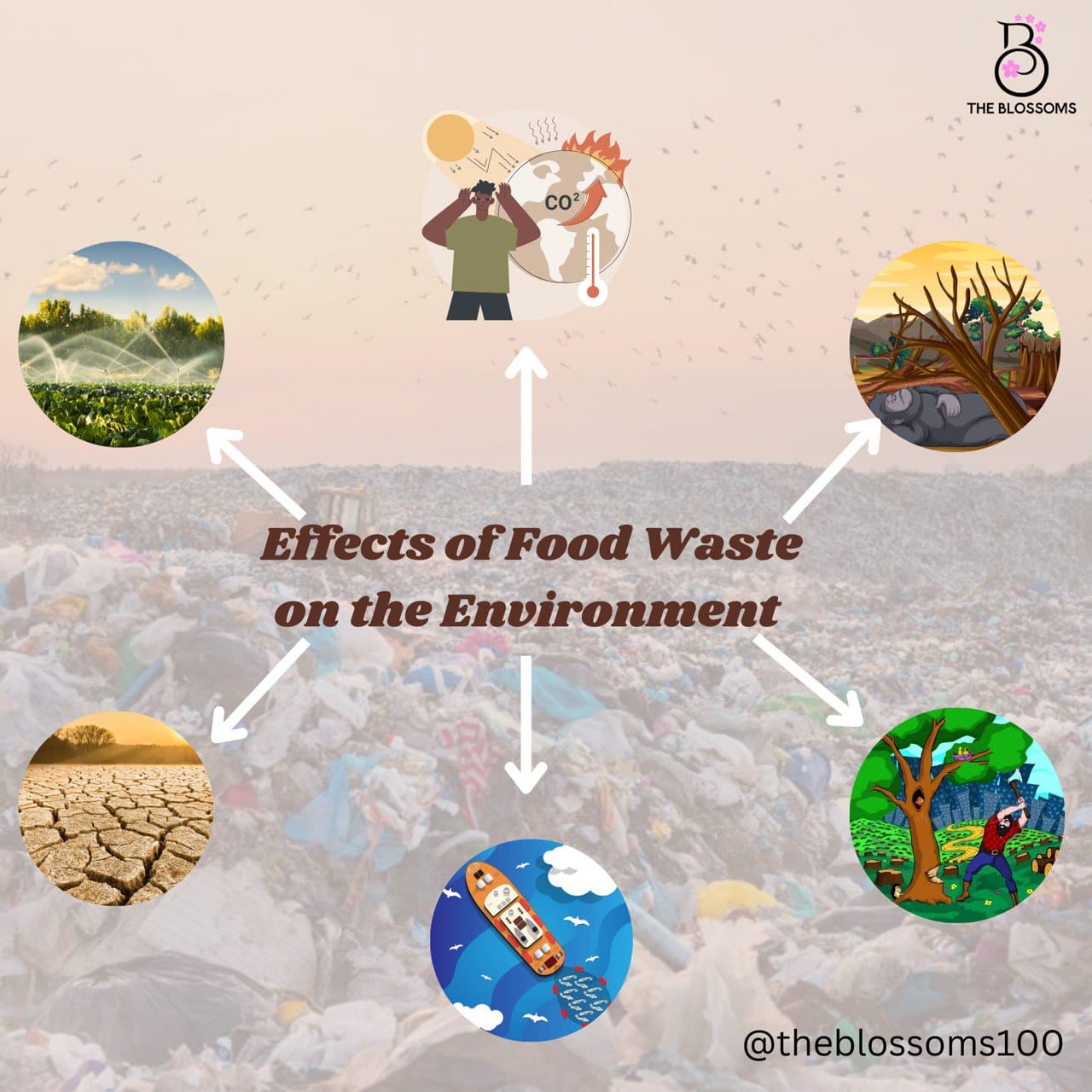
Food Waste ဖြစ်ရတဲ့အကြောင်းအရင်းတွေကို ပြောပြပြီးပြီဆိုတော့ Food Waste ကြောင့် သဘာဝပတ်ဝန်းကျင်အပေါ် သက်ရောက်တဲ့ဆိုကျိုးတွေကို ကြည့်လိုက်ကြရအောင်
Food Wasteတွေကြောင့် သဘာဝပတ်ဝန်းကျင်ကို ထိခိုက်သောနည်းလမ်းများစွာ ရှိပါတယ်။
1. Waste of Natural Resources (သဘာဝအရင်းအမြစ်များပြုန်းတီးခြင်း)
အစားအစာတွေကို ဖြုန်းတီးသောအခါ ထိုအစားအစာများထုတ်လုပ်ရာမှာ အသုံးပြုသည့် အဓိကသဘာဝအရင်းအမြစ်တွေဖြစ်တဲ့ စွမ်းအင်၊လောင်စာနှင့် ရေများအား ဖြုန်းတီးလိုက်ခြင်းနှင့် အတူတူပင်ဖြစ်ပါတယ်။ အစာထုတ်လုပ်ရေးလုပ်ငန်းစဉ် အဆင့်အားလုံးအတွက်သာမက ထုတ်လုပ်သောအစာအမျိုးအစား အားလုံးအတွက် ရေလိုအပ်ပါတယ်။ ကမ္ဘာတစ်ဝန်းမှာ အသုံးပြုနေသောရေတွေရဲ့ ၇၀%ကို စိုက်ပျိုးရေးတွင် အသုံးပြုကြပါတယ်။ ထိုအရာများထဲတွင် သီးနှံများအတွက်လိုအပ်သော ဆည်မြောင်းသွယ်ခြင်း၊ ရေပက်ဖြန်းခြင်း၊ နွား၊ကြက်နှင့် ငါးမွေးမြူခြင်းအတွက် လိုအပ်သောရေများပါဝင်ပါတယ်။ တစ်နည်းအားဖြင့် အစာကိုဖြုန်းတီးခြင်းဟာ ရေချိုကိုပါတစ်ချိန်တည်း ဖြုန်းတီးနေခြင်းဟု ဆိုနိုင်ပါတယ်။ အစာကုန်ကြမ်းထုတ်လုပ်ရာနေရာဖြစ်တဲ့ လယ်ယာလုပ်ငန်းတွေမှာ အသုံးပြုတဲ့ မြေဩဇာရဲ့ ၁၉%၊ ရေချို ၂၁% နှင့် စိုက်ခင်းတွေရဲ့ ၁၈% ကို Food Waste တွေကြောင့် အလဟသဆုံးရှုံးနေရပါတယ်။ ထို့ကြောင့် အမဲသား ၁ကီလိုကို စွန့်ပစ်ခြင်းဟာ ရေ ၅၀၀၀၀လီတာအားစွန့်ပစ်ခြင်းနှင့် ညီမျှသကဲ့သို့ နွားနို့တစ်ခွက်ကို လက်ဆေးကန်ထဲလောင်းချလိုက်ခြင်းသည်လည်း ရေ ၁၀၀၀လီတာနီးပါး အလဟသဖြစ်သွားစေသည့်သဘောနှင့် ညီမျှနေသည်ဟု ဆိုနိုင်ပါတယ်။ ဒါ့အပြင် အချို့နိုင်ငံတွေမှာ ရေပြတ်လပ်မှု ဆိုးဆိုးရွားရွားကြုံနေရပြီး နောက်ဆယ်စုနှစ်အနည်းငယ်အတွင်း လူများနေထိုင်ရန် မသင့်တော်သည့်အခြေနေအဖြစ်သို့ ရောက်လာနိုင်လိမ့်မည်ဟု ပညာရှင်အချို့က ခန့်မှန်းထားကြပါတယ်။
2. Contribution to Climate Change (ရာသီဥတုဖောက်ပြန်ပြောင်းလဲခြင်း)
အမှိုက်ပုံများတွင် အစားအစာတွေပုပ်ပွလာသောအခါ Carbon dioxideထပ် ၂၅ဆ ပိုအားပြင်းသော မီသိန်းဓာတ်ငွေ့များကို ထွက်ပေါ်စေပါတယ်။ ထိုမိသိန်းဓာတ်ငွေ့တွေဟာဆိုရင် နေမှအပူများစွာကိုစုပ်ယူပြီး ကမ္ဘာ့လေထုထဲတွက် ၁၂နှစ်ကြာကြာရစ်ပတ်တည်ရှိနေကာ အပူချိန်များအား မြင့်တက်စေပါတယ်။ ကမ္ဘာလုံးဆိုင်ရာ Greenhouse Gas ထုတ်လွှတ်မှု၏ ၂၀% သည် Food Waste များ၏ အကျိုးဆက်ပင် ဖြစ်ပါတယ်။ အပြည်ပြည်ဆိုင်ရာ စိုက်ပျိုးရေးသုတေသနအဖွဲ့၏ အတိုင်ပင်ခံဟာ (Consultative Group on International Agricultural Research) လေ့လာချက်များအရ လူသားများကြောင့်ဖြစ်သော Greenhouse Gas ထုတ်လွှတ်မှု၏ ၃ပုံ၁ပုံသည် Food Waste များမှဖြစ်ကြောင်း တွေ့ရှိခဲ့ပါတယ်။ အကယ်၍ Food Wasteဟာ နိုင်ငံတစ်နိုင်ငံဖြစ်ခဲ့မည်ဆိုလျှင် ၎င်း၏ Greenhouse Gas ထုတ်လွှတ်မှုသည် အမေရိကန်နှင့် တရုတ်နိုင်ငံတို့ပြီးလျှင် ကမ္ဘာပေါ်တွင် တတိယမြောက်အများဆုံးနိုင်ငံ ဖြစ်လာမည် ဖြစ်ပါတယ်။ ထို့ကြောင့် သင့်တင့်လျောက်ပတ်၍ ထိရောက်သောအစာစွန့်ပစ်မှုစနစ် (Food Waste Treatment System) အားအကောင်ထည်ဖော်နိုင်ပါက ကမ္ဘာလုံးဆိုင်ရာ Greenhouse Gas ထုတ်လွှတ်မှု၏ ၁၁%ကို ရပ်တန့်နိုင်မည်ဖြစ်ပါတယ်။
3. Degradation of Land (မြေဆီဩဇာပျက်စီးခြင်း)
လူသားတွေရဲ့ စည်းကမ်းမဲ့အစာများကို စိုက်ပျိုး၍ စွန့်ပစ်တဲ့အတွက်ကြောင့် သဘာဝမြေဆီဩဇာများ ပျက်စီးဆုံးရှုံရပါတယ်။ ကမ္ဘာ့မြေမျက်နှာပြင်၏ ဟက်တာ ၁၁.၅သန်းကို စိုက်ပျိုးရေးအတွက် အသုံးပြုနေကြပါတယ်။ မြေအမျိုးအစား ၂မျိုးရှိပါတယ်။ “ကောက်ပဲသီးနှံများစိုက်ပျိုးနိုင်သောမြေ (Arable Land)” နှင့် “စားပင်များစိုက်ပျိုး၍မရသောမြေ (Non-arable Land)” တို့ဖြစ်ပါတယ်။ ယနေ့ခေတ်တွင် အသားနှင့် နို့ထွက်ပစ္စည်းများထုတ်လုပ်ရန်နှင့် တိရစ္ဆာန်များမွေးမြူရန်အတွက် Non-arable Land ဟက်တာ ၉၀၀အား အသုံးပြုလျက်ရှိပါတယ်။ အသားများဝယ်လိုအား မြင့်တက်လာသည်နှင့်အမျှ တိရစ္ဆာန်များကျက်စားရန် Arable Land နှင့် သစ်တောများအား ခုတ်ထွင်ရှင်းလင်းဖျက်စီး၍ စားကျက်မြေအဖြစ် ပြောင်းလဲလာကြပါတယ်။ ထိုသို့လုပ်ဆောင်ခြင်းဖြင့် လူသားတွေဟာ သဘာဝပေါက်ပင်၊ စားပင်များ ရှင်သန်ကြီးထွားနိုင်သော အဖိုးတန်မြေဆီများကို တဖြည်းဖြည်း ဖျက်စီးနေကြပါတယ်။ နောက်ဆက်တွဲအနေနဲ့ အနာဂတ်တွင် စိုက်ပျိုးနှုန်းများကျဆင်းမှုသာမက အစာရှားပါးမှုပြဿနာများနှင့်ပါ ကြုံတွေ့လာနိုင်ပါတယ်။
4. Harm to Biodiversity (ဇီဝမျိုးစုံမျိုးကွဲများအား ထိခိုက်စေခြင်း)
ဇီဝမျိုးစုံမျိုးကွဲများ (Biodiversity) သည် ပတ်ဝန်းကျင်၏ ဂေဟစနစ်တွင်ပါဝင်သည့် မတူညီသောမျိုးစိတ်များနှင့် သက်ရှိများကို ရည်ညွှန်းခြင်း ဖြစ်ပါတယ်။ ယေဘုယျအားဖြင့် စိုက်ပျိုးရေးသည် Biodiversity အားထိခိုက်စေပါတယ်။ မွေးမြူရေးထုတ်ကုန်များ ဝယ်လိုအားများလာသည့်အတွက် Mono-cropping ဟုခေါ်သော သီးနှံတစ်မျိုးတည်းအား နှစ်စဉ်စိုက်ပျိုးခြင်း၊ တောရိုင်းမြေများအား စားကျက်မြေအဖြစ်ပြောင်းလဲခြင်း၊ သစ်တောများခုတ်ထွင်ရှင်းလင်းခြင်းကြောင့် သဘာဝသစ်ပင်ပန်းမန်တွေကို ပျက်စီးစေပြီး အချို့တိရစ္ဆာန်များ မျိုးသုဉ်းစေနိုင်သည့် အန္တရာယ်များနှင့် ကြုံတွေ့နေရပါတယ်။ ထို့အပြင် ငါးအလွန်အကျွံဖမ်းခြင်းကြောင့် ပင်လယ်ဂေဟစနစ်များ ပျက်စီးယိုယွင်းလာကာ ရေနေသတ္တဝါအရေအတွက်များလည်း လျော့ကျလာပါတယ်။ ကမ္ဘာ့ပျမ်းမျှ ငါးစားသုံးမှုနှစ်စဉ်အလိုက်တိုးလာမှုသည် လူဦးရေတိုးနှုန်းထက် ကျော်လွန်လျက်ရှိပါတယ်။ တစ်ချိန်တည်းမှာပဲ ဥရောပကဲ့သို့သောနေရာများတွင် စျေးကွက်၏ အရည်အသွေးစံနှုန်းများနှင့် မကိုက်ညီသောကြောင့် ငါးများ၏ ၄၀-၆၀%ကို ပြန်လည်စွန့်ပစ်ကြသဖြင့် အဏ္ဏဝါဂေဟစနစ် (Marine Ecosystem) ကိုသာမက အစာကွင်းဆက်များကိုပါ ဆိုးရွားစွာ အနှောင့်အယှက်ဖြစ်စေပါတယ်။
As we have just covered the causes of food waste and how it is produced, we’ll dive into the effects it can have on the environment.
There are a number of ways in which food waste can affect the environment.
1. Waste of Natural Resources
Waste of food also wastes the three primary natural resources—energy, fuel, and water—used in its production. All phases of the food production process and all generated food types require water. 70% of the water utilized worldwide is used for agriculture. This covers water needed for raising cattle, poultry, and fish as well as irrigation and spraying needed for crops. We waste fresh water when we throw away food. Up to 21% of fresh water, 19% of fertilizer, and 18% of cropland are used in the production of food that is wasted. The amount of water wasted when a kilogram of beef is thrown away is equal to 50,000 liters, while the amount of water wasted when a glass of milk is poured down the drain is almost 1,000 liters. In addition, experts have forecast that certain nations won't be livable in a few decades as a result of water scarcity.
2. Contribution to Climate Change
Food waste releases methane, a potent greenhouse gas that is 25 times more powerful than carbon dioxide, as it rots in our landfills. Methane absorbs solar heat and remains in the atmosphere for 12 years after it is released. It makes up 20% of the greenhouse gas emissions released worldwide. Food waste is responsible for one-third of all greenhouse gas emissions caused by humans, according to research from the Consultative Group on International Agricultural Research. Following the United States and China, food waste would have the third-highest greenhouse gas emissions globally if it were a nation. Therefore, 11% of the world's greenhouse gas emissions would be eliminated if a good food waste treatment system were put in place.
3. Degradation of Land
Our careless usage of food products has a negative effect on the actual land. 11.5 million hectares of the world's land are used for agriculture. "Arable" land is defined as having the ability to grow crops, whereas "non-arable" land is defined as having the inability to do so. Livestock is raised on 900 million hectares of non-arable land to create dairy and meat products. As meat is in higher demand, more arable landscapes are being converted into pastures for animals to graze. By doing this, we are progressively destroying our natural land to the point that nothing can grow naturally on it. Plantations will thus decline, and food shortages can also arise.
4. Harm to Biodiversity
The various species and creatures that comprise the ecosystem of an environment are collectively referred to as biodiversity. Our biodiversity is negatively impacted by agriculture in general. When the demand for livestock production rises, monocropping and transforming our natural lands into pastures and suitable agricultural terrains have become widespread practices. The current natural flora and wildlife are destroyed by deforestation and the conversion of our natural lands into non-arable land, sometimes to the point of extinction. Furthermore, the number of marine life has been shown to be declining, with the massive capture of fish leading to the devastation of our marine ecosystems. According to reports, worldwide fish consumption is increasing faster than population growth yearly. As Europe discards 40-60% of fish because they do not match supermarket quality requirements, while the world continues to overfish and deplete fish supplies, we are causing serious disruptions to marine ecosystems and food chains.
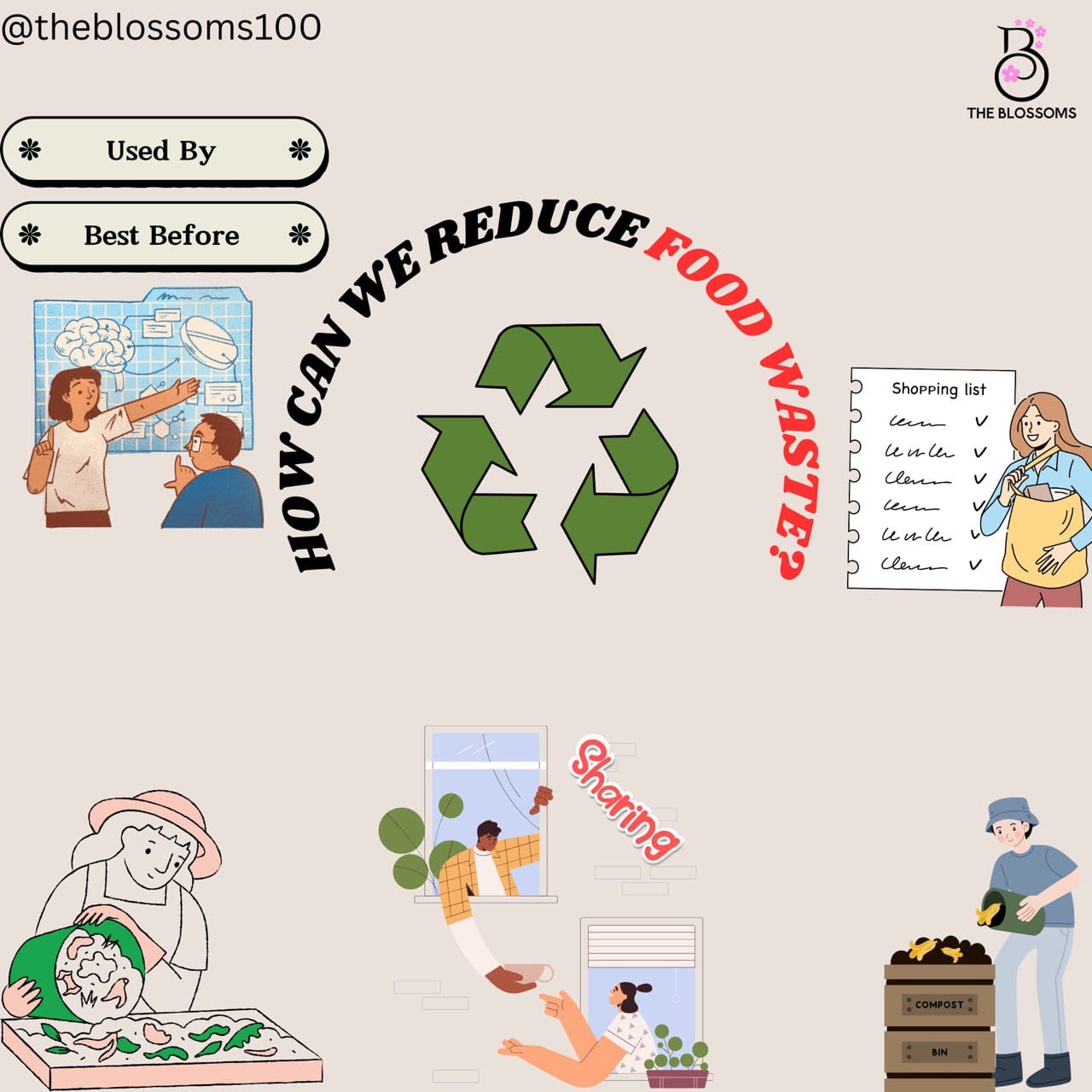
"Food Waste" ကိုဘယ်လိုလျှော့ချမလဲ?
အပေါ်မှာ Food Wasteနဲ့ပတ်သတ်ပြီး ပတ်၀န်းကျင်ပေါ်မှာ ဘယ်လိုအကျိုးသက်ရောက်မှုတွေ လေ့လာပြီးပြီဆိုတော့ အခု Food Wasteကို လွယ်လွယ်ကူကူ လျှော့ချလို့ရမယ့်နည်းလမ်းလေးတွေကို ပြောပြပေးသွားပါမယ်။
1."Prepare and Write Down Shopping List"
-ကျွန်တော်တို့လူသားတွေရဲ့ အမူအကျင့်တွေထဲကတစ်ခုကတော့ ဈေး၀ယ်ထွက်ကြပြီဆိုရင် လိုအပ်တာထက် လိုချင်တာတွေ မလိုအပ်တာတွေကို ပိုပြီး၀ယ်ယူလေ့ရှိပါတယ်။ အဲ့ဒီလိုမျိုး မလိုအပ်တာတွေမ၀ယ်ဖြစ်အောင် ဈေး၀ယ်မထွက်ခင်မှာ ကိုယ်တကယ်၀ယ်ယူမယ့် ပစ္စည်းနဲ့ စားစရာတွေကို ကြိုတင်Listလုပ်သွားပါ။ (Shopping Listကိုသေချာလေးပြင်ဆင်သွားပြီး List ထဲမှာမပါတဲ့ ပစ္စည်းတွေမဝယ်မိဖ်ို့လည်း အရေးကြီးပါတယ်။)
2."Pick Ugly Fruits and Vegetables"
-ဟင်းသီးဟင်းရွက်အညှိုးအနွမ်းတွေနဲ့ သစ်သီးတွေမှာ အနာအဆာအနည်းငယ်ပါတာတွေက အပြင်ပန်းအသွင်အပြင်ပဲ အနာအဆာရှိတာဖြစ်ပြီး စားသုံးလို့ရသေးတာဖြစ်တဲ့အတွက် ၀ယ်ယူကြဖို့လည်းတိုက်တွန်းပါတယ်။
3."Store Food Wisely"
-အစားအသောက်သိုလှောင်တဲ့အခါမှာလည်း အရင်စားရမယ့် အစားအသောက်တွေ၊ ပုပ်သိုးလွယ်တဲ့ အသား၊ငါး၊ဟင်းသီးဟင်းရွက်နဲ့ အသီးအနှံတွေကို မြင်သာတဲ့နေရာမှာထားပြီး လောလောလတ်လတ် ၀ယ်ယူထားတဲ့ အစားအသောက်တွေအရင် စားသုံးသင့်ပါတယ်။
4."Understand Food Labelling"
-အစားအသောက်တွေရဲ့ Expire Dateတွေကြည့်တဲ့အခါ ရက်လွန်သွားပေမယ့် စားသင့်မစားသင့်တွေဝေပြီး မရေမရာဖြစ်ဖူးကြတယ်မလား?
"Best Before"ဆိုပြီး Labelတပ်ထားတဲ့ တစ်ချို့အစားအသောက်တွေကတော့ "Best Before Date"ကိုလွန်ပြီး စားသုံးလို့ရပါသေးတယ်။ ဒါပေမယ့် "Use-by"ဆိုပြီး တွေ့ရင်တော့ သတ်မှတ်ထားတဲ့Dateထက်ကျော်လွန်သွားရင် စားသုံးဖို့မသင့်တော့ပါဘူး။
5."Start Small"
-ကိုယ့်အိမ်မှာကိုယ် ချက်ပြုတ်စားသောက်တာပဲဖြစ်ဖြစ် အပြင်ထွက်စားတဲ့အခါမှာပဲဖြစ်ဖြစ် အလေအလွင့်မရှိစေဖို့ ကိုယ်ကုန်နိုင်မယ့် ပမာဏကိုပဲ သေသေချာချာလေး မှာယူစားသောက်သင့်ပါတယ်။အစားအသောက်အပိုအလျှံတွေကို အိမ်နီးနားချင်းတွေနဲ့ ဝေမျှစားသုံးပါ။ စားသောက်ဆိုင်မှာ မကုန်ခဲ့တဲ့ Leftoversတွေကို ပြန်နွှေးပြီးစားသုံးလို့ရတဲ့အပြင် ခွေးလေး၊ကြောင်လေးတွေကို ကျွေးလို့ရတာဖြစ်တဲ့အတွက် Leftoversတွေကို ယူခဲ့ဖို့ မရှက်ပါနဲ့နော်။
6."Put Your Food Waste to Use"
-အချို့သော အစားအသောက်အကြွင်းအကျန်တွေကို စွန့်ပစ်မယ့်အစား မြေသြဇာအနေနဲ့အသုံးပြုလို့ရတယ်ဆိုတာရော သိပြီးကြပြီလား?
ဥပမာအနေနဲ့ ကြက်ဥခွံတွေမှာ အပင်တွေအတွက် လိုအပ်တဲ့ Nutrientsတွေပါ၀င်တဲ့အတွက် အချို့သောနေရာတွေမှာ အသုံးပြုကြတာ တွေ့ဖူးကြမှာပါ။ ဒီနည်းလမ်းကတော့ Food Wasteအပြင် Carbon Footprintကိုပါ လျှော့ချပေးတဲ့အတွက် အလွန်ကောင်းမွန်တဲ့နည်းတစ်ခုဖြစ်ပါတယ်။
အခုဆိုရင်တော့ အရင်ကသတိမထားမိတဲ့ Food Wasteအကြောင်းကို ပြည့်ပြည့်စုံစုံလေး သိရှိသွားကြမယ်လို့ မျှော်လင့်ပါတယ်။ Food Waste Management Solutionsလေးတွေကလည်း လွယ်ကူရိုးရှင်းတဲ့အတွက် နေ့စဥ်ဘ၀မှာ အသုံးချကြည့်ကြဖို့လည်း မမေ့ပါနဲ့နော်။ "Sharing is Caring"မို့ ကိုယ့်ရဲ့မိတ်ဆွေ၊သူငယ်ချင်းတွေပါ ဗဟုသုတရအောင် Like And Share လေးလုပ်ပေးသွားဖို့တောင်းဆိုပါတယ်။
How to Reduce Food Waste?
We've learned about the effects of food waste on the environment, so now let's explore some easy ways to reduce food waste.
Prepare and Write Down a Shopping List
When we go shopping, we tend to buy things we want rather than what we need which is part of our human behaviors. Before you go shopping, make a list of the items and food you need to buy to avoid unnecessary purchases. It's important to stick to your list and not buy items that aren't on it.
Pick Ugly Fruits and Vegetables
Fruits and vegetables with slight blemishes are still perfectly edible despite their appearance. We encourage you to buy them.
Store Food Wisely
When storing food, place items that need to be eaten first, such as perishable meat, fish, vegetables, and fruits, in a visible location. Consume freshly bought food first.
Understand Food Labeling
Have you ever been unsure about what food you should eat based on its expiration date? Foods labeled as "Best Before" can often be consumed past the specified date, whereas foods labeled as "Use-by" should not be eaten after the date listed.
Start Small
Whether cooking at home or eating out, be mindful to consume only what you can finish. Share any excess food with your neighbors. Don't be shy about taking leftovers home from restaurants; you can reuse them or feed them to your pets like dogs and cats.
Put Your Food Waste to Use
Did you know that some food scraps can be used as fertilizer instead of being thrown away? For example, eggshells contain nutrients that plants need. This method is a great way to reduce both food waste and your carbon footprint.
Now, I hope you will become more aware of food waste and how to manage it effectively. Food waste management solutions are easy and simple, so be sure to incorporate them into your daily life. According to the adage, "Sharing is Caring," so please like and share this information with your friends to spread knowledge.
 THE
THE 